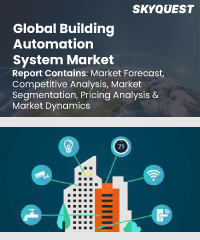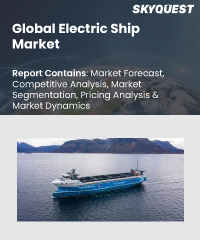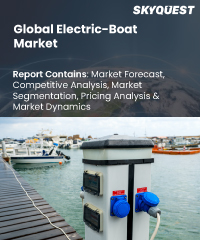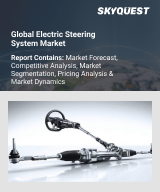USD 36.11 billion

Global Marine Propulsion Engines Market Size, Share, Growth Analysis, By Fuel(Diesel, Heavy Fuel Oil), By Application(Commercial, General Cargo Ships) - Industry Forecast 2024-2031
Report ID:
SQMIG20T2015 |
Region:
Global |
Published Date: April, 2024
Pages:
202
|
Tables:
68 |
Figures:
80
Global Marine Propulsion Engines Market Insights
Global Marine Propulsion Engines Market size was valued at USD 36.11 billion in 2022 and is poised to grow from USD 37.30 billion in 2023 to USD 48.36 billion by 2031, growing at a CAGR of 3.3% in the forecast period (2024-2031).
Marine propulsion engines are crucial to the functioning of any kind of marine vessel such as cargo ships, naval ships, cruise lines, etc. The growth of international trade activity is a prominent factor that is slated to drive marine propulsion engines market growth over the coming years. Increasing shipping activity and a rising number of marine vessels are also slated to benefit market growth. Surging demand for powerful and energy-efficient marine propulsion engines is projected to push market players to invest in R&D and create innovative products. Fuel efficiency and emission reduction are slated to be the prime focus of any marine propulsion engine manufacturer. Implementation of stringent marine emission mandates set forth by governments and organizations such as the International Maritime Organization (IMO) are pushing the industry to innovate and come up with cleaner and sustainable marine propulsion solutions such as hybrid and LNG-powered engines. Research on alternative marine fuels to power new propulsion systems is also gaining traction. Integration of automation and digital control systems in ships is also estimated to augment demand for marine propulsion engines in the future. High investments in the modernization of naval fleets and naval vessels are also slated to offer new growth opportunities for marine propulsion engine suppliers.
Market snapshot - 2024-2031
Global Market Size
Largest Segment
Diesel
Fastest Growth
Diesel
Growth Rate
3.3% CAGR
To get more reports on the above market click here to Buy The Report
Global Marine Propulsion Engines Market Segmental Analysis
The global marine propulsion engines market is bifurcated based on Fuel, Application, Destroyers, Power Range, and region. On the basis of fuel, the market is segmented into Diesel, Heavy Fuel Oil, Natural Gas, and Other Fuels. Based on application, the market is divided into Commercial, General Cargo Ships, Container Ships, Bulk Carriers, Tankers, Defense, and Others. In terms of destroyers, the market is segmented into Frigates, Submarines, Corvettes, Aircraft Carriers, Offshore Patrol Vessels, and Other Vessel Types, Passenger. On the basis of power range, the market is divided into 0-1,000 HP, 1,001-5,000 HP, 5,001-10,000 HP, 10,001-20,000 HP, and Above 20,000 HP. On a regional level, the market is segmented into North America, Europe, Asia Pacific, Middle East and Africa, and Latin America.
Analysis By Fuel
Diesel-powered marine propulsion engines account for a sizeable revenue share and this trend has been going on for quite a while now. High power output, reliability, and fuel efficiency of diesel engines are unmatched and this is why they have remained a preferred propulsion option for marine applications. They are highly suitable for long marine journeys and their high reliability allows them to be popular among the majority of shipowners. Larger vessels with high volume loads that travel long distances are always equipped with diesel engines but increasing availability of alternative fuels and propulsion systems could change the future of this segment.
Natural gas marine propulsion engines are projected to emerge as the fastest-growing segment in the global marketplace owing to the rising focus on sustainability around the world. Implementation of stringent emission mandates for marine vessels and the rising availability of natural-gas-powered propulsion systems are contributing to growth in this segment. Lower levels of sulfur oxides (SOx), nitrogen oxides (NOx), and particulate matter emissions from natural gas-powered propulsion systems are driving their popularity and adoption in the long run. Rising number of shipowners opting for natural gas engines and abundant availability of natural gas at a cheaper cost compared to diesel are also slated to boost growth in the segment over the coming years.
Analysis By Application
Commercial applications account for a dominant share of the global marine propulsion engines marketplace as this segment encompasses a vast range of marine vessels. Cargo ships, tankers, bulk carriers, and container ships all come under the commercial applications segment. Growing international trade and expanding shipping fleets around the world are contributing to the high demand for marine propulsion engines in commercial applications going forward. Growing e-commerce activity is also favoring growth in the commercial segment.
Defense applications are projected to emerge as the fastest-growing segment in the global marine propulsion engines marketplace owing to rising spending on defense and expansion of naval fleets. Growing modernization of naval fleets and mounting geopolitical tensions around the world are slated to uplift the demand for marine propulsion engines in the defense sector going forward. Use of cutting-edge propulsion technologies in military vessels allows them to maneuver rapidly while maintaining their speed and stealth in a mission.
To get detailed analysis on other segments, Request For Free Sample Report
Global Marine Propulsion Engines Market Regional Insights
The Asia-Pacific region accounts for a sizeable share of the global marketplace and this can be linked to countries such as China, Japan, and South Korea. The presence of a massive shipbuilding industry in the aforementioned countries and growing shipping fleets are contributing to high marine propulsion engine sales. Growing offshore activity and rising spending on advanced shipping technologies are also creating attractive growth scope in the Asia Pacific region in the future.
North America is slated to emerge as the fastest-growing regional market in the world, which is particularly backed by countries such as the United States and Canada. Rising demand for recreational boats and yachts, and growing offshore drilling activities are contributing to the rapid market growth in this region. The imposition of strict marine emission mandates by governments in this region is estimated to bolster sales of marine propulsion engines in the long run.
- Largest
- Fastest
To know more about the market opportunities by region and country, click here to
Buy The Complete Report
Global Marine Propulsion Engines Market Dynamics
Drivers
Rising Demand for Commercial Shipping:
- Maritime transportation plays a crucial role in running the global economy and growing international trade activity is projected to bolster demand for marine propulsion engines over the coming years. The expanding world population is driving up the demand for goods and commodities across continents and this is also slated to bolster demand for commercial shipping thereby benefiting marine propulsion engine demand as well.
Environmental Regulations and Fuel Efficiency:
- Governments and marine conservation organizations around the world are implementing strict norms to reduce emissions and carbon footprint from shipping activity. More and more shipowners are focusing on opting for green propulsion technologies to comply with changing regulations and this is projected to favor sales of marine propulsion engines in the long run and push marine propulsion engine manufacturers to invest in the R&D of innovative products.
Restraints
High Initial Costs:
- Getting a marine propulsion engine is a capital-intensive task and so is installing and maintaining it. These high costs can act as constraints for the overall marine propulsion engines market growth as shipowners are hesitant to spend a huge amount of capital which reduces their profit margins. High costs of advanced marine propulsion engines are also estimated to impede market growth in the long run.
Economic Volatility and Overcapacity:
- Fluctuations in economic activity anywhere in the world can have a significant impact on marine propulsion engine demand outlook, which makes this a high-risk market. Reduced trade volumes and excess availability of marine vessels for the same also hurts the overall market growth. Trade disputes, economic crises, and political instability are other factors that could hurt marine propulsion engines market growth in the future.
Request Free Customization of this report to help us to meet your business objectives.
Global Marine Propulsion Engines Market Competitive Landscape
surging demand for sustainable and eco-friendly marine propulsion engines is projected to be the major trend that all market players will be targeting in the future. The implementation of stringent emission mandates and growing demand for efficient propulsion systems in the marine industry are slated to offer lucrative growth opportunities. Established marine propulsion engine companies are projected to invest heavily in the R&D of novel systems that are highly efficient and work on eco-friendly alternative fuels. Partnerships, mergers, collaborations, and acquisitions are estimated to be popular strategies adopted by established as well as aspiring marine propulsion engine vendors around the world. Companies are forecasted to focus on the integration of advanced digital technologies to improve the connected nature of marine vessels allowing shipowners to have better control of their vessels. Predictive maintenance and integration of digital control systems will also be a key trend that companies will focus on to maximize the productivity, reliability, and efficiency of marine vessels.
Top Player’s Company Profile
- Wärtsilä - Finland
- Scania AB - Sweden
- Rolls-Royce Holdings - United Kingdom
- Cummins Inc. - United States
- GE Transportation - United States
- Doosan Infracore - South Korea
- MAN Energy Solutions - Germany
- Volvo Penta - Sweden
- ABC Diesel - Belgium
- PACCAR Inc. - United States
- Yanmar Co., Ltd. - Japan
- Hyundai Heavy Industries - South Korea
- Caterpillar Inc. - United States
- Mitsubishi Heavy Industries - Japan
- Deutz AG - Germany
- Daihatsu Diesel Mfg. Co., Ltd. - Japan
- Textron Inc. (Weber Motor) - United States
- John Deere - United States
- Nigata Power Systems Co., Ltd. - Japan
- ZF Friedrichshafen AG - Germany
- MTU Friedrichshafen GmbH - Germany
- Waagene Purifiner Technology AS - Norway
- Weichai Group - China
- Anglo Belgian Corporation - Belgium
- Fairbanks Morse Engine - United States
Recent Developments
- In March 2024, Hanwha officially launched its new affiliate, Hanwha Engine, after acquiring HSD Engine, the world’s second-largest marine engine firm by market share. The company release stated that Hanwha Engine will be a market leader in the marine engine business.
- In December 2023, MAN Engines expanded its engine portfolio for workboats with the MAN D3872 engine series. The newly developed V12 engine has a 30 L displacement – a first for the company – and is suited for medium- and heavy-duty applications.
- In November 2023, technology group Wärtsilä introduced the marine sector’s first commercially available 4-stroke engine-based solution for ammonia fuel.
Global Marine Propulsion Engines Key Market Trends
- Shift Towards Cleaner and Sustainable Propulsion Technologies: High focus on sustainability and implementation of strict emission mandates for marine vessels have led to a high demand for clean and sustainable marine propulsion engines. Growing number of shipping companies opting for clean propulsion systems powered by sustainable fuels is opening up new avenues of opportunities for different market players. Alternative marine propulsion options, such as LNG (liquefied natural gas), hydrogen fuel cells, battery-electric propulsion, and hybrid systems are slated to witness a hike in popularity in the long run.
- Digitalization and Connectivity for Enhanced Efficiency: Connected ships and digitization of different systems on marine vessels are increasing rapidly. marine propulsion systems that are compliant with advanced digital systems are enabling better fuel efficiency, reliability, and maintenance of marine vessels. Shipowners are increasing the adoption of different digital technologies to enhance the propulsion performance of their ship fleets. Predictive analytics are enabling shipowners to reduce their downtime and cut costs on maintenance to boost productivity and profitability. marine propulsion engine companies can capitalize on the digitization trend to boost their revenue.
Global Marine Propulsion Engines Market SkyQuest Analysis
SkyQuest’s ABIRAW (Advanced Business Intelligence, Research & Analysis Wing) is our Business Information Component types team that Collects, Collates, Correlates, and Analyzes the Data collected by means of Primary Exploratory Research backed by robust Secondary Desk research.
As per Skyquest analysis, growing international trade activity and a rising number of marine vessels around the world are projected to influence the demand for marine propulsion engines over the coming years. A high focus on sustainability and implementation of strict regulations to control emissions from marine vessels is projected to bolster demand for eco-friendly marine propulsion engines in the future. A rising number of shipowners opting for sustainable fuels and propulsion systems is slated to boost market growth. However, the high costs of purchase, installation, and maintenance of advanced marine propulsion engines are projected to be a major restraint for global marine propulsion engines market development in the long run.
The Asia Pacific region is predicted to hold sway over marine propulsion engine sales on a global level owing to the presence of a robust shipbuilding industry and the growing use of sustainable marine propulsion systems. Integration of digital technologies and the use of electric propulsion systems to enhance marine vessel efficiency and performance is projected to be a key trend that will create new opportunities for marine propulsion engine companies going forward.
| Report Metric | Details |
|---|---|
| Market size value in 2022 | USD 36.11 billion |
| Market size value in 2031 | USD 48.36 billion |
| Growth Rate | 3.3% |
| Base year | 2023 |
| Forecast period | 2024-2031 |
| Forecast Unit (Value) | USD Billion |
| Segments covered |
|
| Regions covered | North America (US, Canada), Europe (Germany, France, United Kingdom, Italy, Spain, Rest of Europe), Asia Pacific (China, India, Japan, Rest of Asia-Pacific), Latin America (Brazil, Rest of Latin America), Middle East & Africa (South Africa, GCC Countries, Rest of MEA) |
| Companies covered |
|
| Customization scope | Free report customization with purchase. Customization includes:-
|
To get a free trial access to our platform which is a one stop solution for all your data requirements for quicker decision making. This platform allows you to compare markets, competitors who are prominent in the market, and mega trends that are influencing the dynamics in the market. Also, get access to detailed SkyQuest exclusive matrix.
Buy The Complete Report to read the analyzed strategies adopted by the top vendors either to retain or gain market share
Table Of Content
Executive Summary
Market overview
- Exhibit: Executive Summary – Chart on Market Overview
- Exhibit: Executive Summary – Data Table on Market Overview
- Exhibit: Executive Summary – Chart on Global Marine Propulsion Engines Market Characteristics
- Exhibit: Executive Summary – Chart on Market by Geography
- Exhibit: Executive Summary – Chart on Market Segmentation
- Exhibit: Executive Summary – Chart on Incremental Growth
- Exhibit: Executive Summary – Data Table on Incremental Growth
- Exhibit: Executive Summary – Chart on Vendor Market Positioning
Parent Market Analysis
Market overview
Market size
- Market Dynamics
- Exhibit: Impact analysis of DROC, 2021
- Drivers
- Opportunities
- Restraints
- Challenges
- Exhibit: Impact analysis of DROC, 2021
- SWOT Analysis
KEY MARKET INSIGHTS
- Technology Analysis
- (Exhibit: Data Table: Name of technology and details)
- Pricing Analysis
- (Exhibit: Data Table: Name of technology and pricing details)
- Supply Chain Analysis
- (Exhibit: Detailed Supply Chain Presentation)
- Value Chain Analysis
- (Exhibit: Detailed Value Chain Presentation)
- Ecosystem Of the Market
- Exhibit: Parent Market Ecosystem Market Analysis
- Exhibit: Market Characteristics of Parent Market
- IP Analysis
- (Exhibit: Data Table: Name of product/technology, patents filed, inventor/company name, acquiring firm)
- Trade Analysis
- (Exhibit: Data Table: Import and Export data details)
- Startup Analysis
- (Exhibit: Data Table: Emerging startups details)
- Raw Material Analysis
- (Exhibit: Data Table: Mapping of key raw materials)
- Innovation Matrix
- (Exhibit: Positioning Matrix: Mapping of new and existing technologies)
- Pipeline product Analysis
- (Exhibit: Data Table: Name of companies and pipeline products, regional mapping)
- Macroeconomic Indicators
COVID IMPACT
- Introduction
- Impact On Economy—scenario Assessment
- Exhibit: Data on GDP - Year-over-year growth 2016-2022 (%)
- Revised Market Size
- Exhibit: Data Table on Global Marine Propulsion Engines Market size and forecast 2021-2027 ($ million)
- Impact Of COVID On Key Segments
- Exhibit: Data Table on Segment Market size and forecast 2021-2027 ($ million)
- COVID Strategies By Company
- Exhibit: Analysis on key strategies adopted by companies
MARKET DYNAMICS & OUTLOOK
- Market Dynamics
- Exhibit: Impact analysis of DROC, 2021
- Drivers
- Opportunities
- Restraints
- Challenges
- Exhibit: Impact analysis of DROC, 2021
- Regulatory Landscape
- Exhibit: Data Table on regulation from different region
- SWOT Analysis
- Porters Analysis
- Competitive rivalry
- Exhibit: Competitive rivalry Impact of key factors, 2021
- Threat of substitute products
- Exhibit: Threat of Substitute Products Impact of key factors, 2021
- Bargaining power of buyers
- Exhibit: buyers bargaining power Impact of key factors, 2021
- Threat of new entrants
- Exhibit: Threat of new entrants Impact of key factors, 2021
- Bargaining power of suppliers
- Exhibit: Threat of suppliers bargaining power Impact of key factors, 2021
- Competitive rivalry
- Skyquest special insights on future disruptions
- Political Impact
- Economic impact
- Social Impact
- Technical Impact
- Environmental Impact
- Legal Impact
Market Size by Region
- Chart on Market share by geography 2021-2027 (%)
- Data Table on Market share by geography 2021-2027(%)
- North America
- Chart on Market share by country 2021-2027 (%)
- Data Table on Market share by country 2021-2027(%)
- USA
- Exhibit: Chart on Market share 2021-2027 (%)
- Exhibit: Market size and forecast 2021-2027 ($ million)
- Canada
- Exhibit: Chart on Market share 2021-2027 (%)
- Exhibit: Market size and forecast 2021-2027 ($ million)
- Europe
- Chart on Market share by country 2021-2027 (%)
- Data Table on Market share by country 2021-2027(%)
- Germany
- Exhibit: Chart on Market share 2021-2027 (%)
- Exhibit: Market size and forecast 2021-2027 ($ million)
- Spain
- Exhibit: Chart on Market share 2021-2027 (%)
- Exhibit: Market size and forecast 2021-2027 ($ million)
- France
- Exhibit: Chart on Market share 2021-2027 (%)
- Exhibit: Market size and forecast 2021-2027 ($ million)
- UK
- Exhibit: Chart on Market share 2021-2027 (%)
- Exhibit: Market size and forecast 2021-2027 ($ million)
- Rest of Europe
- Exhibit: Chart on Market share 2021-2027 (%)
- Exhibit: Market size and forecast 2021-2027 ($ million)
- Asia Pacific
- Chart on Market share by country 2021-2027 (%)
- Data Table on Market share by country 2021-2027(%)
- China
- Exhibit: Chart on Market share 2021-2027 (%)
- Exhibit: Market size and forecast 2021-2027 ($ million)
- India
- Exhibit: Chart on Market share 2021-2027 (%)
- Exhibit: Market size and forecast 2021-2027 ($ million)
- Japan
- Exhibit: Chart on Market share 2021-2027 (%)
- Exhibit: Market size and forecast 2021-2027 ($ million)
- South Korea
- Exhibit: Chart on Market share 2021-2027 (%)
- Exhibit: Market size and forecast 2021-2027 ($ million)
- Rest of Asia Pacific
- Exhibit: Chart on Market share 2021-2027 (%)
- Exhibit: Market size and forecast 2021-2027 ($ million)
- Latin America
- Chart on Market share by country 2021-2027 (%)
- Data Table on Market share by country 2021-2027(%)
- Brazil
- Exhibit: Chart on Market share 2021-2027 (%)
- Exhibit: Market size and forecast 2021-2027 ($ million)
- Rest of South America
- Exhibit: Chart on Market share 2021-2027 (%)
- Exhibit: Market size and forecast 2021-2027 ($ million)
- Middle East & Africa (MEA)
- Chart on Market share by country 2021-2027 (%)
- Data Table on Market share by country 2021-2027(%)
- GCC Countries
- Exhibit: Chart on Market share 2021-2027 (%)
- Exhibit: Market size and forecast 2021-2027 ($ million)
- South Africa
- Exhibit: Chart on Market share 2021-2027 (%)
- Exhibit: Market size and forecast 2021-2027 ($ million)
- Rest of MEA
- Exhibit: Chart on Market share 2021-2027 (%)
- Exhibit: Market size and forecast 2021-2027 ($ million)
KEY COMPANY PROFILES
- Competitive Landscape
- Total number of companies covered
- Exhibit: companies covered in the report, 2021
- Top companies market positioning
- Exhibit: company positioning matrix, 2021
- Top companies market Share
- Exhibit: Pie chart analysis on company market share, 2021(%)
- Total number of companies covered
Methodology
For the Global Marine Propulsion Engines Market, our research methodology involved a mixture of primary and secondary data sources. Key steps involved in the research process are listed below:
1. Information Procurement: This stage involved the procurement of Market data or related information via primary and secondary sources. The various secondary sources used included various company websites, annual reports, trade databases, and paid databases such as Hoover's, Bloomberg Business, Factiva, and Avention. Our team did 45 primary interactions Globally which included several stakeholders such as manufacturers, customers, key opinion leaders, etc. Overall, information procurement was one of the most extensive stages in our research process.
2. Information Analysis: This step involved triangulation of data through bottom-up and top-down approaches to estimate and validate the total size and future estimate of the Global Marine Propulsion Engines Market.
3. Report Formulation: The final step entailed the placement of data points in appropriate Market spaces in an attempt to deduce viable conclusions.
4. Validation & Publishing: Validation is the most important step in the process. Validation & re-validation via an intricately designed process helped us finalize data points to be used for final calculations. The final Market estimates and forecasts were then aligned and sent to our panel of industry experts for validation of data. Once the validation was done the report was sent to our Quality Assurance team to ensure adherence to style guides, consistency & design.
Analyst Support
Customization Options
With the given market data, our dedicated team of analysts can offer you the following customization options are available for the Global Marine Propulsion Engines Market:
Product Analysis: Product matrix, which offers a detailed comparison of the product portfolio of companies.
Regional Analysis: Further analysis of the Global Marine Propulsion Engines Market for additional countries.
Competitive Analysis: Detailed analysis and profiling of additional Market players & comparative analysis of competitive products.
Go to Market Strategy: Find the high-growth channels to invest your marketing efforts and increase your customer base.
Innovation Mapping: Identify racial solutions and innovation, connected to deep ecosystems of innovators, start-ups, academics, and strategic partners.
Category Intelligence: Customized intelligence that is relevant to their supply Markets will enable them to make smarter sourcing decisions and improve their category management.
Public Company Transcript Analysis: To improve the investment performance by generating new alpha and making better-informed decisions.
Social Media Listening: To analyze the conversations and trends happening not just around your brand, but around your industry as a whole, and use those insights to make better Marketing decisions.
Global Marine Propulsion Engines Market Report Snapshots
Want to customize this report?
Our industry expert will work with you to provide you with customized data in a short amount of time.
REQUEST FREE CUSTOMIZATION



 USA (+1) 351-333-4748
USA (+1) 351-333-4748
